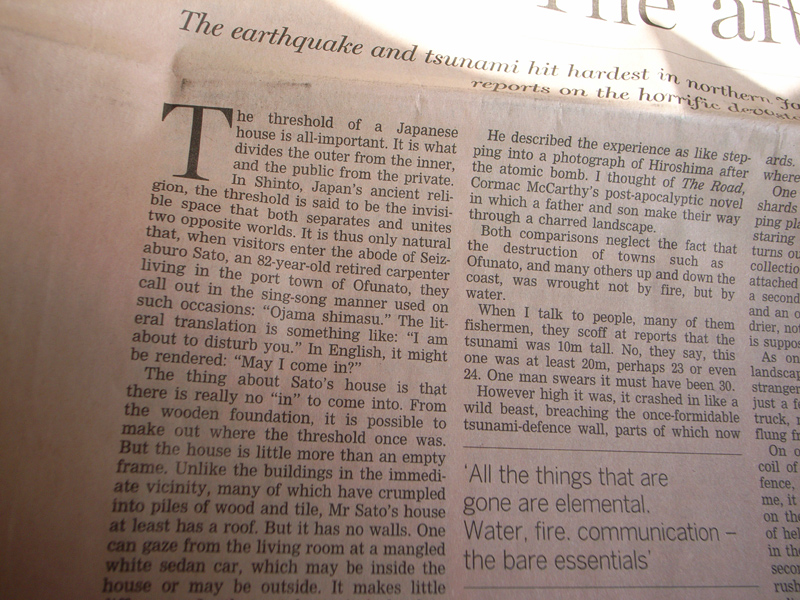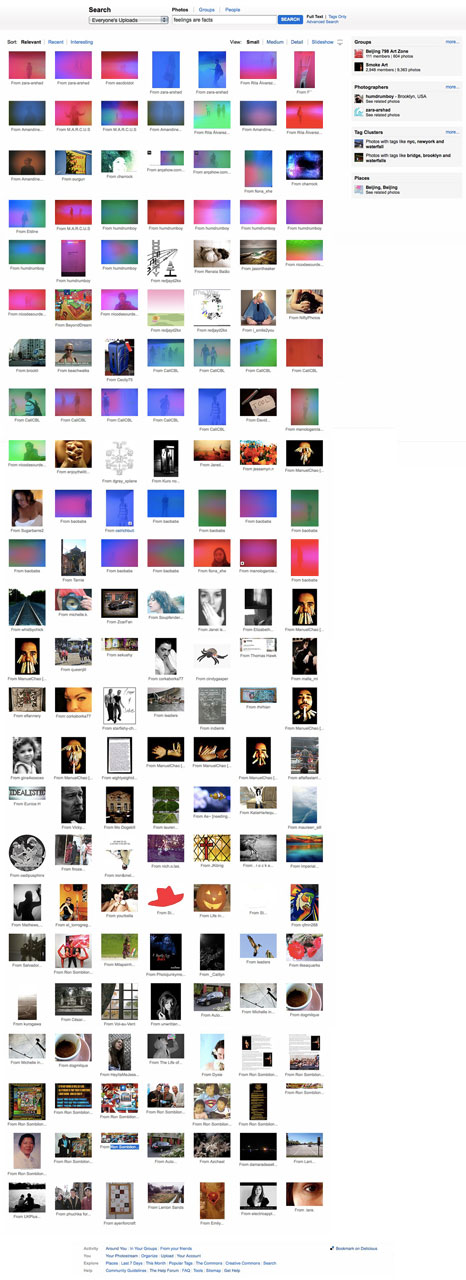For politics to take place, the body must appear. I appear to others, and they appear to me, which means that some space between us allows each to appear. We are not simply visual phenomena for each other – our voices must be registered, and so we must be heard; rather, who we are, bodily, is already a way of being “for” the other, appearing in ways that we cannot see, being a body for another in a way that I cannot be for myself, and so dispossessed, perspectivally, by our very sociality. I must appear to others in ways for which I cannot give an account, and in this way my body establishes a perspective that I cannot inhabit. This is an important point because it is not the case that the body only establishes my own perspective; it is also that which displaces that perspective, and makes that displacement into a necessity. This happens most clearly when we think about bodies that act together. No one body establishes the space of appearance, but this action, this performative exercise happens only “between” bodies, in a space that constitutes the gap between my own body and another’s. In this way, my body does not act alone, when it acts politically. Indeed, the action emerged from the “between.”
— Judith Butler, http://eipcp.net/transversal/1011/butler/en
fracture
ojama shimasu
the distance of death
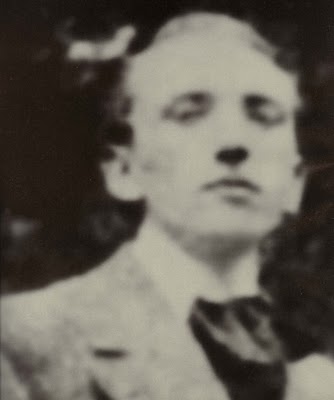
My speech is a warning that at this very moment death is loose in the world, that it has suddenly appeared between me, as I speak, and the being I address: it is there between us as the distance that separates us, but this distance is also what prevents us from being separated, because it contains the condition for all understanding. Death alone allows me to grasp what I want to attain; it exists in words as the only way they can have meaning. Without death, everything would sink into absurdity and nothingness.
–Maurice Blanchot, The Work of Fire, pp. 323-324
the human is this break



 “Humour is, then, the experience of the essential lack of self coincidence. That is to say, humour is a powerful example of what we might call the human being’s eccentricity with regard to itself. Perhaps the most fundamental feature of what it means to be human is the fact that we do not coincide with ourselves, the material body that I am is not the same as the experience of thinking that I have. That is, there is an experiential gap between being and having, between the being that one is and having a relation to that being. More plainly stated, the human being has a reflective attitude towards its experiences and towards itself. This is why human beings are eccentric, because they live beyond the limits set for them by nature by taking up a distance from their immediate experience. In living outside itself in its reflective activity, the human being achieves a break with nature. The philosophical anthropologist Helmuth Plessner goes further and claims that the human is this break, this gap between being and having, between the physical and the psychical. The working out of the consequences of the eccentric position of the human is the main task of a philosophical anthropology, which is why laughter has such an absolutely central place in Plessner’s work.”
“Humour is, then, the experience of the essential lack of self coincidence. That is to say, humour is a powerful example of what we might call the human being’s eccentricity with regard to itself. Perhaps the most fundamental feature of what it means to be human is the fact that we do not coincide with ourselves, the material body that I am is not the same as the experience of thinking that I have. That is, there is an experiential gap between being and having, between the being that one is and having a relation to that being. More plainly stated, the human being has a reflective attitude towards its experiences and towards itself. This is why human beings are eccentric, because they live beyond the limits set for them by nature by taking up a distance from their immediate experience. In living outside itself in its reflective activity, the human being achieves a break with nature. The philosophical anthropologist Helmuth Plessner goes further and claims that the human is this break, this gap between being and having, between the physical and the psychical. The working out of the consequences of the eccentric position of the human is the main task of a philosophical anthropology, which is why laughter has such an absolutely central place in Plessner’s work.”
–simon critchley, infinitely demanding
The pursuit of error
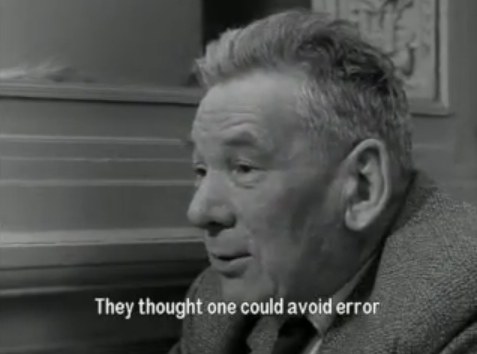
The pursuit of truth seems to have been pretty much a constant in the official history of all human endeavor: science, ethics, politics, education, even aesthetics and romance all take their bearings from the implicit and apparently self-evident horizon of Truth. Even liars adhere to the supremacy of the truth they strive to travesty or conceal. Yet, ensconced as it may be in common sense, that apparent self-evidence is somewhat troubling. For the paradox, of course, is that if we need truth as our guiding beacon then it can only be because we are errant bodies in a world replete with error. And being in denial about that paradox has led our verists to some massive hypocrisy and not much verism of any substance at all. But what if it were the other way round? What if truth was not an earthly principle at all? Where would that leave us? Not in the hands of the relativists, to be sure, because they too have their shifting horizon of explanatory truth, which they call relativism. What if the ordering principle of reality were error itself? What would that mean? How could we face up responsibly and honestly to something so apparently irresponsible? By denying it even as errors continue to accumulate daily? Or playing with it, to tease out… not its truth but its potential?
—-excerpt from original post by Steven Wright at NorthEastWestSouth (please read further also for insightful comments!)
affect and microshocks
JM: Then what precedes the event? What gives rise to it?
BM: Shock. That’s what Peirce says. Affect for me is inseparable from the concept of shock. It doesn’t have to be a drama. It’s really more about microshocks, the kind that populate every moment of our lives. For example a change in focus, or a rustle at the periphery of vision that draws the gaze toward it. In every shift of attention, there is an interruption, a momentary cut in the mode of onward deployment of life. The cut can pass unnoticed, striking imperceptibly, with only its effects entering conscious awareness as they unroll. This is the onset of the activation I was referring to earlier. I’d go so far as to say that this onset of experience is by nature imperceptible.
This is one way of understanding “microperception,” a concept of great importance to Deleuze and Guattari. Microperception is not smaller perception; it’s a perception of a qualitatively different kind. It’s something that is felt without registering consciously. It registers only in its effects. According to this notion of shock, there is always a commotion under way, a “something doing” as James would say. There is always a something-doing cutting in, interrupting whatever continuities are in progress. For things to continue, they have to re-continue. They have to re-jig around the interruption. At the instant of re-jigging, the body braces for what will come. It in-braces, in the sense that it returns to its potential for more of life to come, and that potential is immanent to its own arising.
You can sometimes feel the in-bracing itself, most noticeably in startles or frights. Before you can even consciously recognize what you’re afraid of, or even feel that it is yourself that is the subject of the feeling, you are catapulted into a feeling of the frightfulness of the situation. It only dawns on you in the next instant that you’d better figure out what might have done the catapulting, and what you should do about. It is only then that you own the feeling as your own, and recognize it as a content of your life, an episode in your personal history. But in the instant of the affective hit, there is no content yet. All there is is the affective quality, coinciding with the feeling of the interruption, with the kind of felt transition I talked about before. That affective quality is all there is to the world in that instant. It takes over life, fills the world, for an immeasurable instant of shock. Microperception is this purely affective rebeginning of the world.
– Brian Massumi, “Of Microperception and Micropolitics“
At risk, Facticity.
C = the condition of not knowing (gap) the possibility of being wrong
If there are no false facts, if the very possibility of the undoing of the verity of a fact is a condition of its being, then what are facts at all, as there are no absolute truths? facticity’s relativity becomes its very demise.
Cloudiness as a form of ambivalence, a sign of pretentiousness or insecurity. Such a wide spectrum from which misassumptions may arise, as the two often get mistaken for one another, and yet it was not my intention to propose falsehoods but let us in the least offer the conditions for possibility. Yours appears to me a world of absolutes and war. If the other can only exist as with or not-with, all presuppositions being made, the other can only exist as a response to you. Division is practice gravitating around one. No one else should exist in their own right. There are no third options, and increasing clarity is a meddling with belief, “feelings are facts” are truths are a name borrowed, and that’s simply great.
Let us hope that we act in pursuit of certain truths, at the level of valuation rather than facticity. Is action with an assumption of truth the same as action in belief? To believe with such certainty your own “truth”fulness may negate the need for communication at all, all others (not-with) being mere falsehoods (is this no hierarchy?). Or rather, a cruising for a bruising.
What else is there? Where is the third term, and what forms of dialogue could manifest them? What is C if it is a non-affirmation, a radical passivity? Can such passivity exist ex-stasis, as a language of linkages and motion rather than objects? To move one’s self besides oneself, no longer a subject, ecstasy, spaces in-between. This conversation began by a notion of two. You and your audience as binary, but if we would dare leave the spaces of solidity (it was our high school physics teacher Mr. B who taught us the value of absolutes while he tormented us during examination periods with bells attached to his shoes. “Never ASSUME. It makes an ASS out of U and ME.“), we find a neither-and; a condition C, being outside the self, of not knowing yet not quite not-self either. Infinitely tied to self, C is always conjunctive, one whose very possibility takes us outside of the frames of assumption.
Michael Snow’s Corpus Callosum
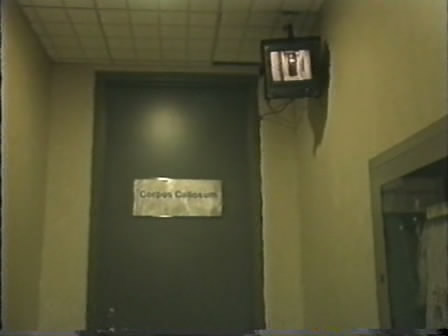
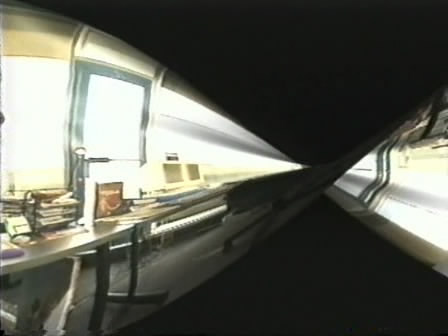

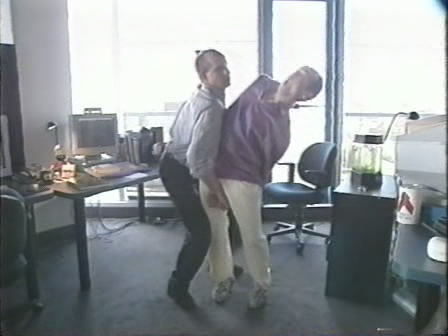
The corpus callosum is a central region of tissue in the human brain which passes “messages“ between the two hemispheres. Corpus Callosum, the film (or tape, or projected light work), is constructed of, de-picts, creates, examines, presents, consists of, and is, “betweens.“ Between beginning and ending, between “natural“ and “artificial,“ between fiction and fact, between hearing and seeing, between 1956 and 2002. It’s a tragi-comedy of the cinematic variables. Corpus Callosum juxtaposes or counterpoints a realism of normal metamorphosis (two extreme examples: pregnancy, explosions) in believable, “real“ interior spaces with “impossible“ shape changes (some made possible with digital animation). First the camera, then we in the audience, observe the observations of the “real“ people depicted in the obviously staged situations. What we see and what they “see“ is involved in shifting modes of belief. There seem to be (though there is no narrative) a Hero and Heroine. However, from scene to scene they are different people costumed identically or altered electronically. The sound – electronic like the picture – is also a continuous metamorphosis and as the film’s “nervous system,“ is as important to the film as the picture. Or: the sound and the picture are two hemispheres joined by the artist. Corpus Callosum is resolutely “artificial, “ it not only wants to convince, but also to be a perceived pictorial and musical phenomenon.
— Michael Snow (quoted here via ArtTorrents, quoted via via…)
The political-economic transformation of late twentieth-century capitalism
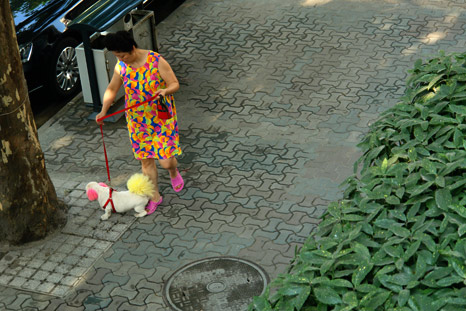
The interval between the decay of the old and the formation and establishment of the new, constitutes a period of transition, which must always necessarily be one of uncertainty, confusion, error, and wild and fierce fanaticism.
– John Calhoun, quoted in The Condition of Postmodernity, by David Harvey
“when the lighthouse is dark between flashes”
“Actuality is when the lighthouse is dark between flashes: it is the instant between the ticks of the watch: it is a void interval slipping forever through time: the rupture between past and future: the gap at the poles of the revolving magnetic field, infinitesimally small but ultimately real. It is the interchronic pause when nothing is happening. It is the void between events.”
– george kubler, THE SHAPE OF TIME, 1962
(from the press release of discovering absence, sounds interesting, maybe you go?)
suspended collapse (“a brief suspension that allows for the appearence of a gap within language itself”)
Speech Practice: Suspended Collapse
A rehearsal for one reader and two writers
“… the whole edifice toppled towards the street and would have crashed down into it had not its slow fall been met by that of the house opposite …”
Heinrich von Kleist, The Earthquake in Chile
Speech Practice: Suspended Collapse is located within a situation that constantly sets aside any reference applied to it. Yet, pushing for a collapse of the given situation this rehearsal speculates on a brief suspension that allows for the appearance of a gap within language itself.
Speech Practice: Suspended Collapse is a rehearsal for one reader and two writers. Hosted by acting from zero at the GfKFB am Flutgraben, Berlin, it will be displayed at the same time in the showroom Scriptings at Korjespoorsteeg 9/12, Amsterdam.
Speech Practice: Suspended Collapse takes place on Wednesday, 1 July, 14.00-22.00 hours. You can attend the rehearsal online at the Department of Reading and at Scriptings at Korjespoorsteeg 9/12.
Speech Practice is part of the project Ongoing propositions under different conditions by Sönke Hallmann and Achim Lengerer. The series is dedicated to the simultaneous performance of reading, writing and speech within a rehearsal situation. This rehearsal takes place with the participation of Inga Zimprich.
http://automatist.net/deptofreading/wiki/pmwiki.php/SpeechPracticeSuspendedCollapse
Rambling About The Language Of Slaves
Or ex-slaves. My whole theory of beautiful language holds that it comes from nameless, groups of people looking for a more expressive way to say something. I’m always thankful to get a note where someone praises a sentence I wrote. But what I really want is the kind of genius that takes “I’m leaving” and turns it into “I’m ghost” and then takes “I’m ghost” and turns it into “I’m Swayze.” Seriously, what kid decided to pull “Ducat” out of obscurity (at least obscurity for us 80s city kids) and use it as easy as bread, or ends, or greenbacks? Who decided that a gun should be called a “heater” and then a “toaster” and then finally a “biscuit”?
A lot of the most vivid language, I find, often comes from the street. I mean that in the broadest sense–that language that’s alive comes from places where people (black, white, brown, yellow, whatever) are living close to the ground. Perhaps I’ve just spent too much time around those sorts of people. But I swear, I’ve heard some of the most evocative language come from the most formally unlettered people.
I thought about this yesterday, while I was listening to another David Blight lecture. He started quoting from Bailey Wyatt, a freedman at an early Union League meeting, and I was just spellbound. Blight has a cool voice, but it was the words that got me:
We now as a people desires to be elevated, and we desires to do all we can to be educated, and we hope our friends will aid us all they can. I may state to all our friends and to all our enemies that we has a right to the land where we are located. Why? I’ll tell you. Our wives, our children, our husbands, has been sold over and over again to purchase the lands we now locates upon. For that reason we have a divine right to the land. And then didn’t we clear the lands and raise the crops of corn and of cotton and of tobacco and of rice and of sugar and of everything? And then didn’t them large cities in the North grow up on the cotton and the sugars and the rice that we made? Yes, I appeal to the South and to the North, if I hasn’t spoken the words of the truth. I say they have grown rich, and my people are poor.
There are all sorts of things wrong with that passage. But there is something beautiful about the extra “s” on desire, especially placed in a sentence like “and we desires to do all we can to be educated.” And then this phrase, “the lands we now locates upon.” Again, all sorts of things wrong with that sentence, but something about it’s immediacy, its understatement, and maybe it’s very wrongness.
I used to be a djimbe drummer. I thought it was going to be my life, at one point. The best lead drummers would play in such a way that they sometimes almost sounded off-beat–not off-beat like a guy who doesn’t know what he’s doing, but off-beat like a guy who can hear pockets in the rhythm that you can’t. It’s the same for great dancers. The same for hip-hop. Great MCs hear more.
Not saying that old Bailey was Rakim. But he heard a little more….Or maybe I’m just making excuses for my own grammatical failings.
[by Ta-Nehisi Coates, originally published 19 june 2009 in The Atlantic]
the lapse at the venice biennale this year…
Only by recognizing lapses do we realize our ability to restructure memory. Today, visual archives from the media form our collective memory. Is it possible to reveal diverse memory formations conceivable through lapses?
The “Lapses” project, developed for the Pavilion of Turkey, consists of projects that demonstrate how the perception of “occurring events” can vary and lead to the differing narrations of history because of lapses in collective memory. The project has been realized through works by two artists: Banu Cennetoglu’s “CATALOG” and Ahmet Ögüt’s “Exploded City”. Both projects reveal the possibility for diverse memory formations or diverse narratives, conceivable through lapses.
[from the press release of Lapses, curated by Basak Senova | Pavilion of Turkey, 53rd International Art Exhibition, La Biennale di Venezia]
* and small note, regarding the small lapse that you’re right i didn’t notice until just now, it’s a question about our own failures as to the lack of a collective memory that this all is, but at least i keep hoping… will you go to the biennale this year?
someone’s liberal copy-pasting, your professor
“Film’s undoubted ancestor…is — architecture.” (Sergei M. Eisenstein)
“Space… exists in a social sense only for activity — for (and by virtue of) walking… or traveling.” (Henri Lefebvre)
“Geography includes inhabitants and vessels.” (Gertrude Stein)
Writing on the architectonics of the traveling eye/I, my opening title got misspelled. By mistake, “sightseeing” became “siteseeing.” As per its Latin root, an error implies a departure from a defined path. Error incorporates erring — the act of traveling and wandering about. By way of such error, I make a theoretical move. Siteseeing signals a shift in film theory away from its focus on sight towards constructing a theory of site — a cartography, that is, of film’s position in the terrain of spatial arts and practices. My erring is ultimately a movement from optic to haptic. The English language makes the transition from sight to site aurally seamless. Siteseeing is a “passage,” out of the theory of the gaze. Many aspects of the moving image — for example, the acts of inhabiting and traversing space — could not be explained within the framework of theories of the eye. Locked within a fixed gaze, the film spectator was turned into a voyeur. Speaking of siteseeing implies that, because of film’s spatio-corporeal kinetics, the…
[full text available here]
from Chapter 3: “The Political Economy of Belonging and the Logic of Relation”
What would it mean to give a logical consistency to the in-between? It would mean realigning with a logic of relation. For the in-between, as such, is not a middling being but rather the being of the middle—the being of a relation. A positioned being, central, middling, or marginal, is a term of a relation.
— a few pages from chapter 3 of Brian Massumi’s Parables for the Virtual [pdf, 1.2mb]
jean-luc nancy on the sacred as spacing, on kawara
It is therefore the sacred, sacred painting, which is in question. That is to say, not painting used to represent religious themes, but the sacred proper to painting itself – and, in general, to the re-productive technique of the world. The sacred operates by setting aside or setting apart, insofar as this distancing is the condition of the relation or of communication – or more precisely, insofar as this gap is the condition of the infinitude of the relation. (The sacred is nothing other than the ordinary condition of communication: reserve, threshold, access without access.)
Painting cuts out a space – the most basic sacred gesture, the trace of the templum. The templum is the cut-out of the heavens, the caeli lucida templa that Lucretius speaks of and also calls magnas caeli cavernas.2 The templum is a hollowing-out of the heavens which defines relations, and, consequently, non-relations as well.
– from “The Technique of the Present“, by Jean-Luc Nancy
hesitating, again (and again and again)
“Like a submerged theme or anathema, hesitation seems to leave a strangely blurred trail that comes into sharp focus wherever – in the long history of the West – a culture of action and a culture of work are refracted and reflected on. Hesitation accompanies the imperative of action and making things happen like a shadow, like ruinous opponent. One could speak here of a hesitation-function: wherever acts manifest themselves and chains of action are organized, there will always be a marked slackening, a pause, a stopping, an interruption. This also establishes an asymmetrical relationship to time and history. Insofar as action, according to Nietzsche, unfolds within forgetting at the same time as bringing forth history, its shadow, hesitation breaks through this history, stepping outside of its context to evoke a specific memory: a memory of what has not been, of a past that was never present, of acts and actions that will not take place – or not yet.
Let’s turn to a different, active aspect of hesitation that distances itself from any basis in lethargy. This second aspect includes an idiosyncratic accuracy, an idiosyncrasy at odds with the solidity of global situations, the irrevocability of verdicts, the finality of solutions, the certainty of consequences, the duration of conformities, and the weight of results. Plus a well-founded mistrust of any belief in salvation through progress. Procrastination begs to differ. It is the articulation of a complicated mindset which, rather than looking for answers to questions and solutions to problems, assumes that the given answers and solutions contain further questions and that problems remain unsolved. Surrounded by solutions, one does not necessarily find the corresponding problems. Hesitation presupposes complexity: its arithmetic gets carried away with smaller and smaller numbers. It endures linearity and the monotony of the world reluctantly, if at all: “Now the fact is that this world is uncommonly and notoriously manifold, which can be put to the test at any moment if one just takes up a handful of world and looks at it a little more closely.” (Franz Kafka)”
(Joseph Vogl, On Hesitation, 2007)
oh oh oh, getting excited again, it all resonates in my head (or am i just looking for excuses for my own failures..). is there a way to produce hesitation? what would it look like? how can you give it space and time, let it unfold?
language breaking down
in response to a question from the audience last night, irit rogoff talked briefly about the over-valorization of language and the moments where we can see language breaking down – not as failure but as opening up new imaginative spaces.
this is exactly what i’m talking about.
my camera is broken, the music was on
what about accidents?

Accidents have always fascinated me. It is the intellectual scapegoat of the technological; accident is diagnostic of technology. To invent the train is to invent derailment; to invent the ship is to invent the shipwreck. The ship that sinks says much more to me about technology than the ship that floats! Today the question of the accident arises with new technologies, like the image of the stock market crash on Wall Street. Program trading: here there is the image of the general accident, no longer the particular accident like the derailment or the shipwreck. In old technologies, the accident is “local”; with information technologies it is “global.” We do not yet understand very well this negative innovation. We have not understood the power of the virtual accident. We are faced with a new type of accident for which the only reference is the analogy to the stock market crash, but this is not sufficient.
—Paul Virilio, from an interview with James der Derian
manifeste du tiers paysage
a third landscape, interstices, thresholds, cracks and loopholes.. resorting to science again (biology this time)..
“in the space smoothed over by capitalism, we must imagine other spaces to invest: grooves, cracks, breaches, loop-holes. we must multiply the modalities to act on the edge, the margins, the borders. in permaculture, we refer to the ‘border effect’; the ‘margin effect’ and Clement* reminds us that there is more life where environments meet and overlap: ‘limits-interfaces, canopies, borders, thresholds, outskirts-in themselves comprise biological layers. their wealth is often superior to the environments that they divide’. in the spaces of ‘biological depth’, energy is concentrated and intensified by difference, by the encounter with other species.”
…
“Clement tells us that these cracks form a ‘tiers paysage’ – ‘third landscape’ which comprises ‘a territory for the multiple species which find nowhere else to be'”
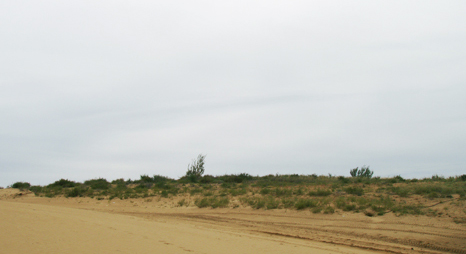 traces of a third landscape, singing sand desert, inner mongolia
traces of a third landscape, singing sand desert, inner mongolia
(from Constantin Petcou/Doina Petrescu, “Acting Space – Transversal notes, on-the-ground observations and concrete questions for us all”)
to go outside the space of encounter
“- with the term ‘error,’ you mean to say that things neither show nor hide themselves, not yet belonging to the ‘region’ where there is a place for unveiling and veiling.
– did i say that? i would say rather: error is an obstinacy without perseverance that, far from being a rigorously maintained affirmation, pursues itself by diverting the affirmation toward what has no firmness. essential error is without relation to the true, which has no power over it. truth would dispel error, were they to meet. but there is an error of sorts that ruins in advance all power of encounter. to err is probably this: to go outside the space of encounter.
– i confess to not understanding well your ‘error.’ there would be two kinds: one being the shadow of the true; the other-but this other, i wonder how you can speak of it.
– this is perhaps the easiest. speech and error are on intimate terms.”
(maurice blanchot, the infinite conversation – more to come..)
more from “the error and the event”
“In order to further understand the event and the way in which an error may slip into existence we may turn to Deleuze’s philosophy of the virtual. This philosophy is not a philosophy of events that actually take place. Rather it is a philosophy of events that could have potentially taken place if things had been different. As DeLanda points out in his commentary on Deleuze, studying the virtual is not an investigation of the events that actually occurred in a system, but rather understanding the system based on the events that could have potentially taken place, if certain circumstances had been different (DeLanda 35). The virtual is the field of potential, the event is the becoming actual of the virtual; it is the actualisation of one event from the multiplicity of the virtual. The virtual that Deleuze theorises is a mode of reality that is articulated in the emergence of new potentials; the virtual is implicated in the reality of change (Massumi). So, in this framework, we can think of the error as the potential that may or may not come into existence. The system that seeks the actualisation of unforeseen potential is thus also a system that has the capacity to become errant. We can think of any system that is open to the unforeseen as surrounded by a cloud of potential errors, or, as Deleuze would put it, a cloud of the virtual (Deleuze and Parnet 148). In other words, at any moment, any system that seeks the unforeseen, the novel or the new is involved in the process of actualising potential information. At any moment this system is traversing a field of potential. Within this field exists the virtual error, waiting to be actualised by an errant system. At any point in its process, a system is traversing potential errors and at any point, one may become actualised.
As a system attempts to actualise this unformed information, to form the unformed from the cloud of the virtual, the system may also give form to an unformed error. Rather than thinking of an event as the process by which preformed or preconceived possible information becomes realised, we can only think of an error as coming into being as the unformed and the unforeseen potential is actualised. This potential emerges from unique activities that occur in the process of a system. These unique activities open the system so that unforeseen information may emerge (DeLanda 36-37). If a system runs through its process without the potential for error it is essentially closed. It does not allow the potentiality of the emergent or the unforeseen. It is only through allowing the capacity for potential errors that we may provide the opportunity to think the unthought, to become-other, and to hence initiate further unforeseen becomings in the virtual (Rodowick 201). In a sense, when there is potential for an error to emerge in a system, the system cannot be regarded as a pre-formed linear progress, rather it can only be thought as a divergent process that actualises elements of the virtual.
Kim Gascone has previously pointed to the artists that exploit this potential for error in order to create what he calls a ‘glitch aesthetic’. Artists such as the composer Ryoji Ikeda, (http://www.ryojiikeda.com/) who create compositions that exploit the inadequacies of the medium, use errors as generative tools. In these instances, artists set up situations in which errors are able to emerge and be exploited in the art making process. In these types of work the artist’s role is to allow a glitch or an error to arise in a specific system, then to reconfigure and exploit the generative qualities of the unforeseen error. This type of practice is also taken up in the visual arts by Artists such as Tony Scott (http://www.beflix.com/works/glitch.php) who set up situations in which errors are able to emerge and be exploited in the art making process. In these types of work the artist’s role is to allow a glitch or an error to arise in a specific system, then to reconfigure and exploit the generative qualities of the unforeseen error.”
– from “The Error and the Event” by Tim Barker. Vector e-zine #6, errors and glitches
from “The Error and the Event”
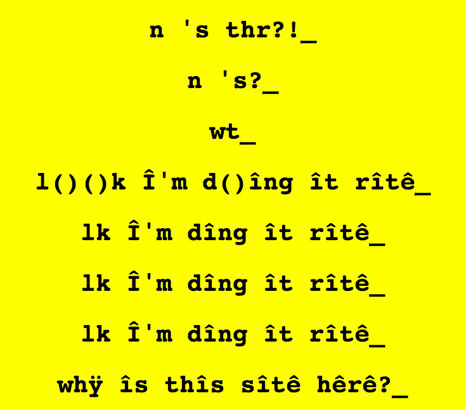 image from http://404.jodi.org
image from http://404.jodi.org
If time were laid out on a timeline, with one earlier event directing a later event then the emergence of an error, in this neat system of cause and effect, would be relatively predictable. We could see that when A occurs it produces B —– the error. But this is not the way time is, and it is not the way events exist either in our day to day lives or in interaction with a digital system. Events exist, as A.N. Whitehead and Gilles Deleuze tell us, as complexes of occasions, all enfolded in the one event, not as a neatly linear sequence of compartmentalised occasions. B is thus enfolded in A, for B —–the error—–to be brought into existence it must be unfolded from A (Whitehead The Concept of Nature 75). Here I take my starting point from Whitehead’s process philosophy and Deleuze’s philosophy of the virtual. These philosophers provide us with a means to understand the event, and, by extrapolating from these thinkers, a means to understand the event of the digital encounter. Once we understand the event through this framework we can begin to examine the place of errors in this system.
Deleuze answers the question “What is an event?” in a short chapter in The Fold: Leibniz and the Baroque, one of the few times that he mentions Whitehead. In this chapter Deleuze, aligns himself with Whitehead’s thought in order to think the event in relation to his own work on the fold (Deleuze 76-82). He credits Whitehead as the philosopher who importantly situated the event as the central constitutive element of reality. The connection between the way in which Deleuze uses the event and Whitehead’s initial categorisation and explanation of the scheme has been cited previously by theorists such as Isabelle Stengers and Ilya Prigogine, as well as Steve Shaviro and Tim Clark (Prigogine and Stengers 387-89; Stengers; Shaviro; Clark). For all these thinkers, although there are no one to one correspondences between Whitehead’s and Deleuze’s thought, Whitehead and Deleuze’s ideas work together to produce a mode of thought which takes the virtual elements of the event and the notions of permanence and flux within and between multiplicities as its theoretical ground. In this paper I situate the event of interactive media art within this theoretical framework and attempt to conceptualise the error as the actualisation of unforeseen potential within this system of flux.
Paul Patton’s work on elucidating the Deleuzian event is useful here. Patton points out that Deleuze takes his concept of an event from the Stoics. He points out that the Stoics drew a fundamental distinction between two realms of being, a material realm of bodies and states of affairs, referred to as actual, and an incorporeal realm of events, referred to as the virtual (Patton). For Patton, the Deleuzian events are the “epiphenomena” of corporeal causal interactions: they do not affect bodies and states of affairs but they do affect other events, such as the responses and actions of agents. In other words events are the incorporeal attributes of material bodies. Patton gives the example of being cut with a knife. The fact of ‘being cut’ is neither a property of the flesh nor of the knife, it is rather, as Patton puts it, an attribute or the “interpenetration of bodies” (Patton). Following this, it may be possible that the fact of ‘being errant’ is neither a property of the human nor of the machine but rather an attribute of the condition of their interrelationship. The human and the machine interpenetrate one another in order to affect the state of the error, to bring the error into existence.
– from “The Error and the Event” by Tim Barker. Vector e-zine #6, errors and glitches
no-logs
a game called No-Logs by Sarai’s cybermohalla project:
When we speak, how do we make sense of the listener? The game of no-log is played when the listener keeps saying “I didn’t understand”. Without losing patience, a practitioner of no-logs keeps developing the argument or the story that s/he started to share. The practitioner has to go on and discover feelings, impressions, imageries, stories, anecdotes, examples, to make it increasingly difficult for the listener to say “I didn’t…”.
language and philosophy and politics
You must have read this already, little circle with scratches in it (trying to decipher your margin notation system), but why not another hurrah for minor practices…
Languages are the jargons that hide the pure experience of language just as peoples are the more or less successfull masks of the factum pluralitatis. This is why our task cannot possibly be either the construction of these jargons into grammars or the recodification of peoples into state identities. On the contrary, it is only by breaking at any point the nexus between the existence of language, grammar, people and state that thought and praxis will be equal to the tasks at hand. The forms of this interruption—-during which the factum of language and the factum of community come to light for an instant—-are manifold and change according to times and circumstances: reactivation of a jargon, trobar clus, pure language, minoritarian practice of a grammatical language, and so on. In any case, it is clear that what is at stake here is not something simply linguistic or literary but, above all, political and philosophical.
(from Giorgio Agamben, “Languages and Peoples”, 1995)
i was wondering if he was speaking of the coming to light of language and community as a truthfulness in a somewhat sinister sense, as in weaknesses, the wrongdoings of language and maybe even community, but on further thought i realised my own old qualifications… i suppose he references its multitude-ness in that we cherish language and community as much as it hampers us, this being factum for simply what is, whereby the cracks of language, jargon and the escapes from grammar give us the unconcealing of language and community.
obtuse acute right
“a blunting of a too evident meaning, a too violent meaning”, “causes my reading to skid”, “opens onto the infinity of language”, “ultimately, the obtuse meaning can be seen as an accent, the very form of an emergence, of a fold (even a crease) marking the heavy layer of information and signification”
i started reading and copying from the book, and instead of emailing this, i put it here. oh and i just checked the definition of ‘obtuse’ and first thing that comes up is “annoyingly insensitive or slow to understand” (slow slow delay delay)
“as for the other, the third meaning, the one which appears ‘in excess’, as a supplement my intellection cannot quite absorb, a meaning both persistent and fugitive, apparent and evasive, i propose calling it the ‘obtuse meaning’. this word readily comes to my mind, and miraculously, upon exploring its etymology, i find it already yields a theory of the supplementary meaning; obtusus means blunted, rounded. Now, the features I have indicated–makeup, whiteness, false hair, etc– are they not a kind of blunting of a too evident meaning, a too violent meaning? do they not give the obvious signified a kind of ineffable roundness, do they not cause my reading to skid? an obtuse angle is greater than a right angle: an obtuse angle of 100º, says the dictionary; the third meaning, too, seems to me greater than the pure perpendicular, the trenchant, legal upright of the narrative. it seems to me to open the field of meaning totally, i.e., infinitely. I even accept, for this obtuse meaning, the word’s pejorative connotation: the obtuse meaning seems to extend beyond culture, knowledge, information. analytically, there is something ridiculous about it; because it opens onto the infinity of language, it can seem limited in the eyes of analytic reason. it belongs to the family of puns, jokes, useless exertions; indifferent to moral or aesthetic categories (the trivial, the futile, the artificial, the parodic), it sides with the carnival aspect of things. obtuse therefore suits my purpose well.”
…
“the obtuse meaning is not in the language system (even that of symbols). remove it and communication and signification remain, circulate, pass. without it i can still speak and read, but it is not in speech either; it may be that there is a certain constant in the Eisensteinian obtuse meaning, but then this is already a thematic speech, an idiolect, and this idiolect is temporary; for there are obtuse meanings not everywhere (the signifier is a rare thing, a future figure) but somewhere: in other authors of films (maybe), in a certain way of reading “life” and hence “reality” (here understood in its simple opposition to the deliberately fictive).”
…
“the same uncertainty when it is a matter of describing the obtuse meaning (of giving some idea of where it is going, where going away); the obtuse meaning is a signifier without signified, whence the difficulty of naming it: my reading remains suspended between the image and its description, between definition and approximation. if we cannot describe the obtuse meaning, this is because, unlike the obvious meaning, it copies nothing: how describe what represents nothing? here the pictorial “rendering” of words is impossible. consequently, if we remain, you and I, on the level of articulated language in the presence of these images–that is, on the level of my own text–the obtuse meaning will not come into being, will not enter into the critic’s metalanguage. which means that the obtuse meaning is outside (articulated) language, but still within interlocution. for if you look at these images i am talking about, you will see the meaning: we can understand each other about it “over the shoulder” or “on the back” of articulated language: thanks to the image (frozen, it is true: I shall return to this), indeed thanks to what in the image is purely image (and which, to tell the truth, is very little indeed), we do without speech yet continue to understand each other.
in short, what the obtuse meaning disturbs, sterilizes, is metalanguage (criticism). we can offer several reasons for this. first of all, the obtuse meaning is discontinuous, indifferent to the story and to the obvious meaning (as signification of the story); this dissociation has a contra naturam or at least a distancing effect with regard to the referent (to “reality” as nature, a realist instance).”
…
“ultimately, the obtuse meaning can be seen as an accent, the very form of an emergence, of a fold (even a crease) marking the heavy layer of information and signification.”
…
“this accent (whose simultaneously elliptical and emphatic nature we have discussed) does not tend toward meaning (as in hysteria); it does not theatricalize (Eisenstein’s decorativeness belongs to another realm); it does not even indicate an elsewhere of meaning (another content, added to the obvious meaning), but baffles it –subverts not the content but the entire practice of meaning.”
…
“the obtuse meaning can proceed only by appearing and disappearing”
…
“the third meaning, which we can locate theoretically but not describe, then appears as the transition from language to signifying (signifiance) and as the founding act of the filmic itself.”
(roland barthes, the third meaning)
and i remembered her mistakes too
“Rose did go on smelling and breathing and pushing and shoving and rolling, she sometimes just rolled, and moving. anything on a mountain side is moving, rocks are rolling, stones are turning, twigs are hitting, trees are growing, flowers are showing and animals are glowing that is their eyes are and everywhere there oh dear everywhere there well Rose was there and so was her chair.
How many minutes go around to make a second how many hours go round to make a minute how many days go around to make an hour how many nights go round to make a day and was Rose found. She never had been lost and so how could she be found even if everything did go around and around.”
is it greek?
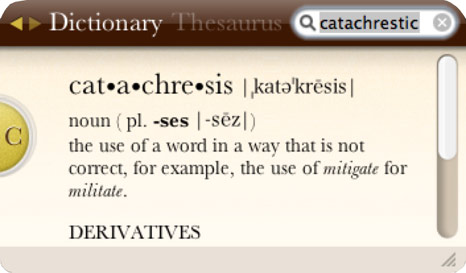
ma

trying to find more about it, but for now: “Ma means an interval in time and space, but it is much more than just a blank space. It is best described as a concept related to commenting on, or engaging in, the Japanese arts such as: Kabuki, Noh, dance, storytelling, music, calligraphy and painting. When ma is used in conjunction with the arts it relates to rhythm and breathing (it was originally a concept related to music). It can best be described in theater as a dramatic pause in spoken lines, in music it is interpreted according to each musician’s taste and how one wishes to space the notes. In painting, the empty space (ma) is used to enhance the whole of the painting.”
thinking about the interval, the interruption, the distance that separates and that makes relation possible (blanchot..)
and “every relation, every separation between two instants, two places, two states: Ma” (Barthes, L’Intervalle, 1978 – we have to find this text..)
and…and…and…
it’s as though, in a way, he’s always stammering. not stammering in words, but stammering in language itself. you can normally only be a foreigner in another language, but here it’s a case of being a foreigner in one’s own language.
..
and isn’t even a specific conjunction or relation, it brings in all relations, it upsets being, the verb… and so on. And, “and…and…and…” is precisely a creative stammering, a foreign use of language, as opposed to a conformist and dominant use based on the verb ‘to be’.
..
when godard says everything has two parts, that in a day there’s morning and evening, he’s not saying it’s one or the other, or that one becomes the other, becomes two. because multiplicity is never in the terms, however many, nor in all the terms together, the whole. multiplicity is precisely in the “and,” which is different in nature from elementary components and collections of them.
..
and is neither one thing nor the other, it’s always in-between, between two things; it’s the borderline, there’s always a border, a line of flight or flow, only we don’t see it, because it’s the least perceptible of things. and yet it’s along this line of flight that things come to pass, becomings evolve, revolutions take place.
(deleuze on godard, from negotiations)
the first post is hesitating thought
“Hesitation avails itself through stops and starts, restarts, still more restarts. Hestitation is practiced through montage-reading-thinking-writing. The Event. Hestitation in evoking sublimity can, in turn, evoke terror, awe, and fear. Or as others say in a different vocabulary: Dislocation. JumpCut. Relocation. Jumpcut. Can evoke Distantiation. Estrangement. Resulting in feelings of stupidity. Before the other. The text or the jagged-scape or the distantiated film opens up a colossus of possibilities, or rather incompossibilities (i.e., a libidinal economy of coexistent worlds).” [from Victor Vitanza seminar, ‘Jean-Francois Lyotard: Hesitating Thought’]
please excuse the narcissistic thought, but today raised a hesitant hand in class, only to follow the discussion quickly too quickly, the ‘opportune moment’ missed, and the hand goes back down again and the thought seems futile again. he noticed afterwards, smiling gently about the need for a marketing manager, and once again all the multiplicity of these positivisms, the third order questions, seem equal and simultaneous to an utter nihilism, oh and… oh, and. is pure democracy the same as my paralysis? even if the river never flows the same stream twice, isn’t it still a river? and if we can meet all these flips of coins, these linkages of thoughts, you really won’t still tell me how? there is no means of doing, yes, it was just in the doing. he hates “to be”. The singular. Identification is time. How do you count? All these possibilities, are they are a doing, the precursor to doing, what are we doing. Still? Yes we’ve heard it before! And that’s great. A non-negative, you are here.
